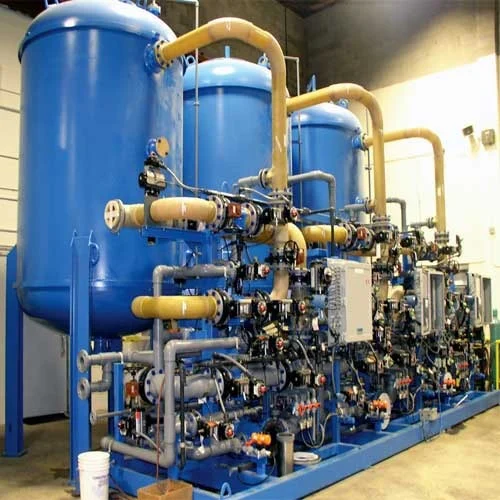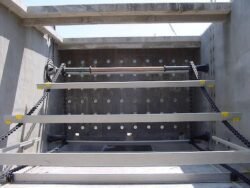
Las Vegas Advanced Wastewater Treatment Plant

Introduction
Amid the shimmering lights and bustling life of Las Vegas, Nevada, lies a critical yet often overlooked infrastructure marvel—the Las Vegas Advanced Wastewater Treatment Plant (LVAWWTP). This facility plays an indispensable role in sustaining the vibrancy of the city, a desert oasis famed for its exuberant nightlife and bustling tourism industry. With a service population of over 2.7 million residents and millions of annual visitors, efficiently managing wastewater is paramount.
Population Served and Wastewater Volume
Las Vegas’s population dynamics present unique challenges and opportunities for wastewater management. The metropolitan area, home to over a million residents and welcoming more than 42 million tourists annually, generates an enormous volume of wastewater that requires meticulous treatment. During peak seasons, the influx of tourists can nearly double the city’s temporary population, amplifying the need for robust and flexible treatment mechanisms.
The LVAWWTP services not only the city itself but also the surrounding Clark County and other neighboring regions. The plant handles an impressive average of 100 million gallons of wastewater daily. During peak times, this volume can climb significantly, underscoring the plant’s need for advanced, scalable treatment methods.
Treatment Capacity and Technological Advancements
The Las Vegas Advanced Wastewater Treatment Plant is designed with a treatment capacity of up to 150 million gallons per day (MGD). This capacity ensures that the plant can handle both the everyday wastewater load and the surges that result from the city’s thriving tourism sector.
The plant utilizes a range of cutting-edge technologies to ensure that wastewater is treated to the highest standards before being discharged into the Las Vegas Wash, which eventually flows into Lake Mead, a vital water source for the southwestern United States.
Primary Treatment
Primary treatment involves the removal of large solids and grit through screening and sedimentation. These preliminary steps are crucial for protecting subsequent treatment processes and improving overall plant efficiency.
Secondary Treatment
Secondary treatment employs biological processes to degrade organic matter dissolved in the wastewater. Las Vegas’s plant uses activated sludge systems, where air and microorganisms are introduced to break down waste components. This step is essential for reducing the biochemical oxygen demand (BOD), a critical measure of the organic pollution load.
Tertiary Treatment
The plant’s tertiary treatment processes are particularly advanced. These systems further purify water by removing nitrates, phosphates, and other contaminants through chemical coagulation, filtration, and advanced biological processes. Ozone disinfection is also used to ensure that pathogens are eliminated, making the treated water safe for release or reuse.
Water Recycling and Reuse
One of LVAWWTP’s standout features is its commitment to water recycling and reuse. Treated water is used for irrigation, industrial applications, and even groundwater recharge. This not only conserves precious freshwater resources but also aligns with the city’s broader sustainability goals.
Recent Local News and Developments
In recent years, several key projects and updates have underscored the plant’s role in ensuring sustainable water management in Las Vegas. Here’s a look at some notable developments:
1. Expansion Initiatives
In 2021, the Las Vegas Valley Water District announced a major expansion project for the LVAWWTP. This included upgrading existing infrastructure, introducing new technological solutions, and increasing the plant’s overall capacity. Funded by a combination of municipal bonds and federal grants, this project aims to future-proof the plant against increasing demand and more stringent regulatory requirements.
2. Green Energy Initiatives
In 2022, the LVAWWTP partnered with NV Energy to implement a large-scale solar array installation on its premises. This initiative is part of a broader move to transition to renewable energy sources and reduce the plant’s carbon footprint. The solar panels are expected to generate enough electricity to meet a significant portion of the plant’s energy needs, highlighting an innovative approach to sustainability.
3. Effluent Management and Environmental Protection
Recognizing the environmental impact of treated wastewater discharge, recent efforts have focused on enhancing the quality of effluent released into the Las Vegas Wash. In 2023, the plant introduced enhanced nutrient removal technologies to significantly reduce nitrogen and phosphorus levels, mitigating the risk of eutrophication in downstream water bodies.
Key Projects and Innovations
1. Advanced Monitoring Systems
One of the plant’s main recent upgrades involves the adoption of advanced monitoring systems, which employ AI and machine learning algorithms. These systems provide real-time data analytics, predictive maintenance, and enhanced operational efficiency. By detecting irregularities early, these technologies help prevent potential system failures and optimize resource allocation.
2. Microgrid Development
To boost energy resilience, the LVAWWTP is developing a microgrid that integrates renewable energy sources such as solar and biogas. This development, in collaboration with local utility companies and tech providers, will ensure uninterrupted plant operations even during grid outages, enhancing reliability and sustainability.
3. Public Outreach and Education Initiatives
Understanding that community engagement is crucial for long-term success, the LVAWWTP has initiated several public outreach and educational programs. These initiatives aim to raise awareness about water conservation, the importance of wastewater treatment, and the role of advanced technologies in safeguarding public health and the environment.
Community Engagement
Engaging with the community is an integral part of LVAWWTP’s operational philosophy. The plant’s leadership understands that fostering a strong relationship with the public can lead to better compliance, increased public support for infrastructure projects, and heightened awareness about environmental issues.
1. Tours and Open Houses
The plant regularly organizes tours and open houses, inviting local residents, school groups, and policymakers to witness first-hand the sophisticated processes involved in wastewater treatment. These events often feature interactive displays, presentations by engineers and scientists, and hands-on activities designed to demystify the treatment process.
2. Educational Workshops
In conjunction with local schools and educational institutions, the LVAWWTP conducts workshops and seminars focusing on various aspects of environmental science, engineering, and sustainability. These programs aim to inspire the next generation of environmental stewards and water industry professionals.
3. Public Feedback Mechanisms
The plant maintains an open channel for public feedback, allowing residents to voice their concerns, suggestions, or inquiries regarding wastewater management. Regular community meetings and forums provide a platform for dialogue, ensuring transparency and accountability in plant operations.
4. Digital Outreach
Recognizing the power of digital media, the LVAWWTP has an active online presence, regularly updating its website and social media platforms with news, educational content, and updates on ongoing projects. Online campaigns and virtual tours have also gained popularity, especially during the COVID-19 pandemic, allowing wider accessibility and engagement.
Conclusion
The Las Vegas Advanced Wastewater Treatment Plant stands as a testament to the city’s commitment to sustainable and innovative water management solutions. Serving millions of residents and visitors, the plant navigates the complexities of high wastewater volumes and stringent environmental standards with remarkable efficiency.
With ongoing expansions, cutting-edge technological upgrades, and a strong focus on community engagement and education, the LVAWWTP is not just a critical infrastructure asset but also a model for future wastewater treatment facilities worldwide. As Las Vegas continues to grow and evolve, the plant’s role in preserving water resources and protecting the environment will undoubtedly remain as crucial as ever.

